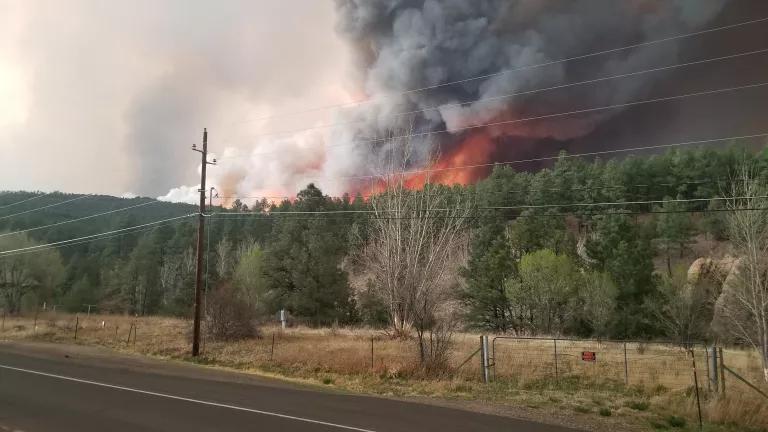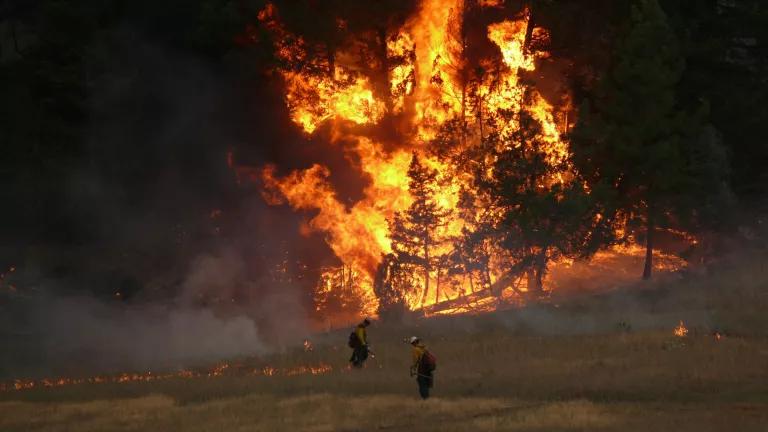In New Mexico: Climate Is on the Call
Climate policy will be at the heart of New Mexico’s short legislative session this year.

A photovoltaic array at the University of New Mexico-Taos Klauer Campus in Taos
Climate policy will be at the heart of New Mexico’s short legislative session this year. The climate emergency isn’t waiting. As the state faces record drought, December once again broke records as the hottest in the last century. In the middle of winter, fires in neighboring Colorado last month were the most destructive the state has ever seen. There is no time to wait.
In the state’s anachronistically short 30-day session, its leaders are taking on big climate policies. Here are some of the ones we are tracking and advocating for over the next month:
- A climate bill that proposes statewide limits to climate pollution: a 50% reduction in carbon emissions by 2030 and 100% by 2050 (compared to 2005 baseline levels)
- A budget overhaul that includes transformational investments to address the climate crisis and build back better
- The Clean Fuels Standard Act, which will require a 20% cut in transportation fuel emissions intensity by 2030
- Focusing state money on tested climate solutions and job creators- like weatherization and transit- and ensuring nation-leading standards for new fuels or technologies that may have a targeted role like hydroge
The Climate Bill
In November, Governor Lujan Grisham promised to bring forward legislation that would put New Mexico on track to net-zero emissions. As 2022 unfolds, she is delivering on that promise. The administration circulated a draft climate bill, with final legislation to be introduced early in the session. While there will certainly be details to work through, the bill is ambitious: it requires cutting state emissions in half (from a 2005 baseline) by 2030 and getting to zero emissions by 2050 (with up to 10% allowed to be covered by increased sequestration). This bill is a very good starting point, and the Governor’s team is expecting to come back in 2023 to pass a more detailed set of policies to implement these goals.
The Climate Budget: Transformational Investments Needed to Build Back Better
Equipped with a gigantic budget surplus this year, New Mexico must make pivotal investments in clean energy solutions. The state has already made record-setting investments in conservation funding, alongside strides in funding teacher pay, higher education and health care. While these investments are essential to diversifying our economy away from fossil fuels, we won’t stop climate pollution unless we empower families to switch to clean energy. Over the coming decade, the state must fundamentally transform its budget—and invest billions (with a B)—towards a zero-emissions economy. This year’s budget must kickstart that transformation by supporting:
- Community Energy Efficiency Development (CEED) Block Grants: The Legislative Finance Committee allocated $10 million in this year’s budget to improve weatherization and support zero carbon space and water heating in low-income homes. The state will need to invest about another $490 million over the next decade to address all low-income homes. Covering this investment gap means spending at a rate of at least $50 million a year, while using strong surplus years like this one to cover future low revenue years. The CEED bill also must be added to the Governor’s call.
- Workforce transition: The state should empower workers and their families to transition to clean energy employment through just transition programs. These include piloting a stipend program to cover critical training and educational expenses, supporting certified apprenticeship programs, ensuring that new energy investment projects are completed with qualified labor, and supporting high-road employment opportunities.
- Capital outlay dollars should pass a climate test: Every public building and every state vehicle should be zero-emissions by 2030. Decarbonizing the state’s infrastructure relies on investments in energy efficiency, electric heat pumps, rooftop solar, and electric vehicles and accompanying chargers for transitioning municipal and transit fleets.
- NM Department of Transportation (DOT): The state is now slated to receive over $300 million extra a year in federal funding from the Infrastructure Investment and Jobs Act of 2021. Those funds can revitalize New Mexico communities by helping the state invest in electrified transit, improve pedestrian and bike safety, and support affordable transportation in low-income communities Or, it can be used to widen roads, build new roads and highways, and worsen our reliance on polluting vehicles. Which we chose will dictate pollution levels and impacts on our communities for decades. The state is also getting $38 million for new charging infrastructure. Hopefully the state will use it to support well-designed private investments and build on recent successes from the VW settlement funds and the big utility investments in approved by the Public Regulatory Commission.
- Agency budgets: The LFC budget suggests a small increase on existing budgets, but substantially lower than the executive recommendation for EMNRD and NMED, needed to meet the climate emergency. These agencies simply must be fully funded if they are to adequately regulate oil and gas and put in place new rules to cut carbon emissions across the state.
- The federal Build Back Better proposal would create big new incentives for renewable energy, electric vehicles and electric heat pumps for space and water heating. If that bill doesn’t get across the finish line, it will be up to states to ensure we move the market and stop burning fossil fuels in cars and buildings. The technology is available, but adoption will be too slow without support.
Clean Fuels
Lujan Grisham’s administration is bringing back the clean fuels bill that did not quite make it last year. The new bill is twice as ambitious, requiring 20% cuts in fuel emissions intensity by 2030. This would be a big win. The bill still needs a few improvements, like:
- Ensuring any funds that go through utilities keep costs down for customers and support electrification rather than allowing any of the funds to line shareholder and executive pockets. If the state follows through with electric vehicle policies, most credits in this program will be driven by EV charging, which utilities will aggregate, but should only spend on their customers behalf, not for their own enrichment.
- Ensuring the full emissions accounting for liquid fuels, including emissions from transportation and based on fuel source location
Once passed, the Environment Department should first prioritize completing the Clean Cars, Clean Trucks and post 2025 100% ZEV Clean Cars rulemakings, which will be the backbone of transition to a zero-carbon transportation system.
Hydrogen standards and further study needed before further action; Investments should prioritize known and trusted technologies

The Whitewater-Baldy Complex burns through Gila National Forest in May 2012
The technology staples of cutting carbon emissions in New Mexico are known and available: renewable energy, electric vehicles, and more efficient buildings powered by clean electricity. The policies and investments above are all focused on these solutions, which together cover over 85 percent of the economy’s emissions, and doing so will create new jobs and opportunities in the state. While other technologies will be important, we should not lose sight, in the budget or in policy priority, of the staples.
Much has been made of the possibilities of production in hydrogen in New Mexico. While there is good reason to believe hydrogen will be a part of our zero emissions economy, we have to do it right from the start:
- NM needs strong standards to only produce hydrogen with verifiably minimal to zero lifecycle greenhouse gas emissions, accounting for all major sources of upstream, midstream and on-site production emissions.
- Ensuring any hydrogen investments target truly hard-to-decarbonize end uses where hydrogen is poised to be best suited for the decarbonization task- which may include aviation, maritime shipping, heavy industry and seasonal storage of electricity. This is predicated on the demonstrable fact that hydrogen is a woefully inefficient solution relative to others in most end-uses. State support for hydrogen must be informed by, and preconditioned on, a holistic, rigorous and independent analysis of hydrogen’s most efficient applications relative to other proven and readily available climate solutions
- Further reflecting on hydrogen transport and delivery infrastructure, notably pipelines, before launching into what may be premature and risky investments. For instance, given the long lifetime of hydrogen pipelines, any investment must be predicated on a detailed understanding of the long-term geographical layout of hydrogen demand and supply sources, in efficient pathways to net-zero emissions by 2050. Such knowledge remains decidedly lacking, rendering large-scale investments in hydrogen delivery infrastructure a premature and unsound near-term investment.
New Mexico has a track record of success on climate, including the Energy Transition Act, recent oil and gas regulations and new utility investments in electric vehicles. The state’s leaders, both in the legislature and Governor’s office, are committed to policy and investments to confront the climate crisis and invest in solutions. But we aren’t there yet: the state must pass bold new policies and increase climate investments by orders of magnitude to truly meet this moment.



